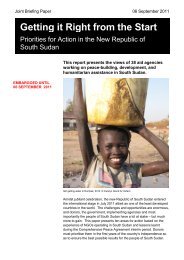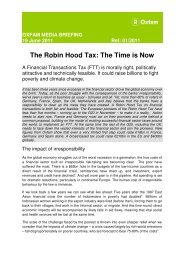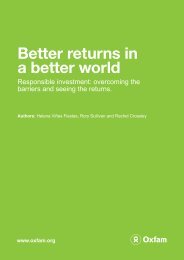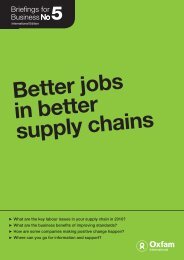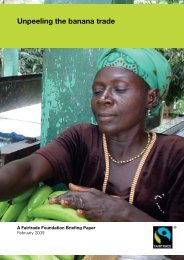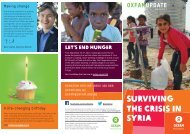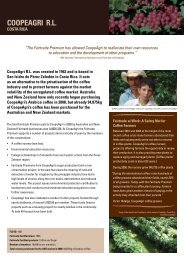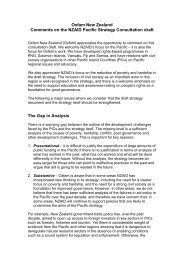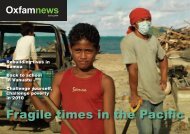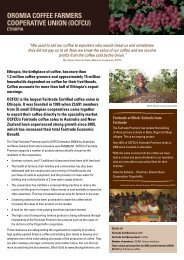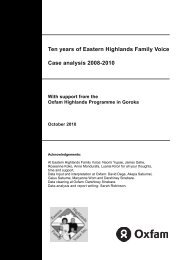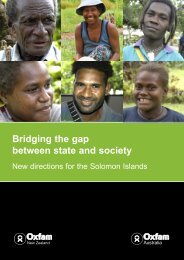Untying food aid allows humanitarian agencies totailor their response to the specific situation: whereappropriate, purchasing food on local markets, orproviding cash or vouchers so that people can buytheir own.Nor is the way humanitarian responses are fundedappropriate for a future of increasing price volatilityand climate chaos. Donors are nearly always asked formoney only once a crisis is already under way, causingdelays that could be avoided through a system ofassessed contributions, such as that used to fund UNpeacekeeping operations.Box 6: Food aid for whom, exactly?With the exception of 2009, over the past two decadesmore than 90 per cent of US food assistance hascome in the form of subsidized crops grown byAmerican farmers. 112 Yet only 40 cents of everytaxpayer dollar spent on US food aid actually goes tobuying food.A big chunk goes straight into the pockets of USagribusiness companies. US legislation specifiesthat 75 per cent of food aid must be sourced, bagged,fortified, and processed by US agribusiness firms withcontracts from the United States Department ofAgriculture (USDA). Bidding processes are dominatedby only a few corporations, leading to payments onaverage of 11 per cent above market rates, and up to70 per cent over the odds in the case of corn.After the food is purchased, US shipping companiesget their turn. Under law, the food must be processedand freighted by American companies on US-flaggedships at taxpayer expense. Nearly 40 per cent of totalfood aid costs are paid to US shipping companies,where again, restricted bidding limits competition andpushes up prices.Such aid takes longer to reach those in need. During2004–08, US food aid to Africa required an averageof 147 days for delivery, compared with 35–41 daysfor food from the African continent. 113 And in situationswhere shipping food aid from the USA would be anappropriate response, <strong>Oxfam</strong> estimates that procuringtransport on the open market would allow theAmerican taxpayer to provide 15 per cent morefood, 114 enough to feed an additional 3.2 million peoplein emergency situations. 115Source: Barrett and Maxwell (2008) Food Aid AfterFifty Years: Recasting its RoleNational level actionUltimately, national governments are accountable to theircitizens for ensuring their right to food. The dysfunctionalinternational system only increases their responsibility todo so. In the face of climate change, increasing resourcescarcity, and food price volatility, governments can andmust do more to build the resilience of their populations.As a first step, governments must invest in agriculture –to improve infrastructure, extend access to productiveresources, and ultimately to increase food productionand incomes in rural communities where hunger isconcentrated. As the examples of India and Brazil show(see Box 7), economic growth is no panacea – growthmust be accompanied by broad-based job creation andsocial transfers if hunger is to be reduced.Governments must also prioritize climate changeadaptation. Their ability to make the needed investments,however, is undermined by the failure to date of richcountries to pin down details of their $100bn a yearpledge for climate financing. Nor is current financingmuch help – recent estimates suggest that as little as10 per cent is actually being channelled towardsadaptation, 116 while most of the $30bn of Fast StartFinance agreed at Copenhagen has turned out to be oldaid money, recycled, repackaged and renamed.If properly planned and adequately funded, adaptationwill also help deliver on other challenges. For example,improving crop storage can help meet the sustainableproduction challenge, while strengthening safety netsand ensuring equitable access to land can helpcontribute to the equity challenge. Scaling up socialprotection systems is another crucial strategy in thegovernment tool box. Cash transfer programmes,employment guarantee schemes, weather-indexed cropinsurance, and social pensions – all can help vulnerablepopulations better cope with shocks. Yet today, 80 percent of the world’s population lack access to socialprotection of any kind – leaving them without a safety netjust as risks are multiplying. 117Right: US food aid: at a government food distribution centre,a sack of corn-soy blend waits for distribution. (Ethiopia, 2008)40Opposite: Weighing rice at the Gor Khamhi centre for thePublic Distribution System. While an important safety netfor hungry people, India’s Public Distribution System (PDS)doesn’t properly satisfy the calorific needs of vulnerablerural communities. (India, 2011)
Box 7: A tale of two BRICSThey may both be members of the BRICS group ofemerging economies, yet on the question of hunger,Brazil and India are poles apart. Despite more thandoubling the size of its economy between 1990 and2005, 118 India failed to make even a tiny dent in thenumber of hungry people. In fact, it increased by 65million 119 – more than the population of France. 120Today, about one in four of the world’s hungry peoplelives in India. 121In Brazil, however, where economic growth has beenslower, hunger has been rolled back at an incrediblepace – the proportion of people living in hunger almosthalved between 1992 and 2007. 122Why this marked difference? There are, of course,many factors at play, but ultimately it comes down togovernment failure in India and government successin Brazil, where a purposeful political leadership wasbuttressed by a strong citizens’ movement led bypeople living in poverty.In India, the government has presided over a longperiod of unequal growth concentrated in the servicessector and urban areas, despite the fact that themajority of poor and hungry people live in rural areas.Had the government undertaken effectiveredistribution, then hunger could still have beenreduced. Sadly, India failed to prioritize hunger ordevelop a coherent strategy. Ambitious initiativessuch as the National Rural Employment GuaranteeAct to provide 100 days of paid work to rural men andwomen, or a massive fertiliser subsidy programme,have been unable to make inroads without sufficientpolitical buy-in and support.In Brazil, the opposite was true. A national crosssectoralstrategy – Fome Zero (Zero Hunger) –launched in 2003, consisted of 50 linked initiativesranging from cash transfers for poor mothers toextension services for small-scale food producers.Crucially, Fome Zero was championed by thenPresident, Luiz Inácio Lula da Silva, which ensuredthe buy-in across government necessary to deliversuch a broad agenda.Although the benefits were realized quickly, FomeZero was a long time coming; the result of 20 yearsof activism from Brazilian civil society and socialmovements. They organized and challenged, andhelped expand the political horizon, electingpoliticians with the vision to make a difference. 123‘Case Study: Brazil’s Strategies to Reduce Hunger’www.oxfam.org/grow‘Why India is Losing its War on Hunger’www.oxfam.org/growTime to rebuildThe broken food system is exacerbating the very driversof fragility that make it vulnerable to shocks. It is locked ina dance of death with the age of crisis it helped to create.Happily, most of the solutions are known, and manynecessary changes are already underway, led bygrowing numbers of consumers, producers, responsiblebusinesses, and civil society organizations. Overcomingthe vested interests at the heart of the system will be thesingle greatest challenge. History shows that justicetends not to come about through the benevolence of thepowerful. Decolonization and independence, thecreation of welfare states, the spread of universalsuffrage, the creation of international governance: allhave been won through struggle and conflict, often linkedto destabilizing shocks or periods of flux. The age ofcrisis is a terrible threat, but also a tremendousopportunity. The prize: a new prosperity in whicheveryone can have a fair share.<strong>Growing</strong> a <strong>Better</strong> <strong>Future</strong>Chapter 2: The age of crisis:a skewed and failing system41



